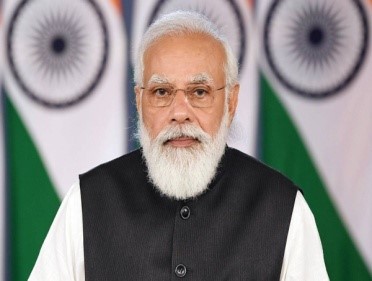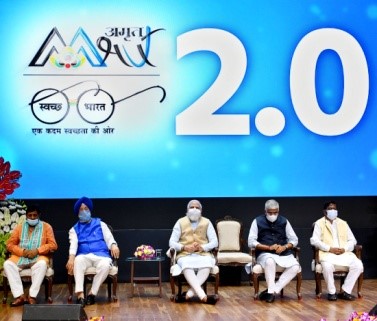
PM MODI LAUNCHED SBM URBAN 2.0 AND AMRUT 2.0
PM MODI LAUNCHED SBM-URBAN 2.0 & AMRUT 2.0
Prime Minister Narendra Modi launched Swachh Bharat Mission-Urban 2.0 and AMRUT 2.0. The missions have been designed to make all our cities ‘Garbage Free’ and ‘Water Secure. The Swachh Bharat Mission 2.0 has been launched with the aim of making the cities garbage-free. PM Narendra Modi said while launching the mission "that with the 2nd phase, we also aim sewage and safety management, making cities water-secure and ensuring that dirty nullahs don't merge into rivers."

Current Affairs Notes By Success Mantra Coaching Institute GTB Nagar Delhi CLICK HERE
SWACHH BHARAT MISSION-URBAN 2.0
- SBM-U 2.0, announced in Budget 2021-22, is the continuation of SBM-U first phase. The government is trying to tap safe containment, transportation, disposal of faecal sludge, and septage from toilets. SBM-U first phase was launched on 2nd October 2014 aiming at making urban India Open Defecation Free (ODF) and achieving 100% scientific management of municipal solid waste. It lasted till October 2019. It will be implemented over five years from 2021 to 2026 with an outlay of Rs.1.41 lakh crore
- Aim: It focuses on source segregation of garbage, reduction in single-use plastic and air pollution, by effectively managing waste from construction and demolition activities and bioremediation of all legacy dump sites. Under this mission, all wastewater will be treated properly before it is discharged into water bodies, and the government is trying to make maximum reuse a priority.
- Mission outcomes: All statutory towns will become ODF+ certified (focuses on toilets with water, maintenance and hygiene). All statutory towns with less than 1 lakh population will become ODF++ certified (focuses on toilets with sludge and septage management). 50% of all statutory towns with less than 1 lakh population will become Water+ certified (aims to sustain toilets by treating and reuse of water). All statutory towns will be at least 3-star Garbage Free rated as per MoHUA’s Star Rating Protocol for Garbage Free cities.
PROGRESS UNDER SBM-U PHASE-I
4,324 urban local bodies have been declared Open Defecation Free, which has been made possible through the construction of more than 66 lakhs individual household toilets and over 6 lakhs community/public toilets, far exceeding the Mission’s targets. Digital enablements such as Swachhata App, the digital grievance redressal platform introduced by MoHUA in 2016, has reinvented the way in which citizen grievance redressal is managed. Swachh Survekshan, the world’s largest urban cleanliness survey covering over 4,000 Urban Local Bodies was initiated under SBM-Urban in 2016.

2ND PHASE OF AMRUT MISSION (AMRUT 2.0)
The Prime Minister also launched the second phase of Atal Mission for Rejuvenation and Urban Transformation (AMRUT 2.0). The Ministry of Housing and Urban Affairs (MoHUA) is the nodal ministry for the scheme.
AMRUT MISSION 2.0
It is the continuation of the AMRUT mission launched in June 2015 to ensure that every household has access to a tap with the assured supply of water and a sewerage connection.
AMRUT 2.0 aims to provide 100% coverage of water supply to all households in around 4,700 ULBs (Urban Local Bodies). It also seeks to promote Atmanirbhar Bharat through encouraging Startups and Entrepreneurs (Public Private Partnership).
Objectives: It will build upon the progress of AMRUT to address water needs, rejuvenate water bodies, better manage aquifers, reuse treated wastewater, thereby promoting a circular economy of water. It will provide 100% coverage of sewerage and septage in 500 AMRUT cities. Recycling and reuse of treated wastewater is expected to cater to 20% of total water needs of the cities and 40% of industrial demand. Under the Mission, fresh water bodies will be protected from getting polluted to make natural resources sustainable. Pey Jal Survekshan will be conducted in cities to ascertain equitable distribution of water, reuse of wastewater and mapping of water bodies.
PERFORMANCE OF AMRUT PHASE-I
1.14 crore water tap connections have been provided taking total connections to 4.14 crore in AMRUT cities. Credit rating work has been completed in 470 cities. Of which, 164 cities have received Investable Grade Rating (IGR), including 36 cities with rating of A- or above. Rs 3,840 crore has been raised through Municipal Bonds by 10 ULBs. The Online Building Permission System has been implemented in 2,471 cities including 455 AMRUT cities. This reform has helped improve India’s rank in Ease of Doing Business in construction permits to 27 in Doing Business Report (DBR) 2020 of World Bank from 181 in 2018. 89 lakh conventional streetlights have been replaced with energy efficient LED lights, leading to estimated energy savings per annum & reduction in CO2 emission.

IMPACT OF THE LAUNCH
Swachh Bharat and AMRUT Mission have both succeeded in bringing about transformative changes in the lives of people since their launch. The missions have not only transformed the urban landscape by adopting scientific approach and engaging citizens, but under Swachh Bharat Mission, urban areas of 35 States/ UTs have become open defecation free. Besides this, over 73 lakh toilets have been built across India that has improved health and sanitation across the country and about 97% homes have door to door waste collection facilities. The missions signify a step towards effectively addressing the challenges of rapidly urbanizing India. They will also aim to achieve the targets set under UN's Sustainable Development Goals 2030.
WHAT IS SWACHH SURVEKSHAN?
Launched as a part of the Swachh Bharat Mission, it is an annual survey of cleanliness, hygiene and sanitation in cities and towns across India. The ranking exercise is taken up by the Government of India to assess rural and urban areas for their levels of cleanliness and active implementation of Swachhata mission initiatives in a timely and innovative manner. Swachh Survekshan-Urban is conducted by the Ministry of Housing and Urban Affairs. Swachh Survekshan-Rural is conducted by the Ministry of Jal Shakti. Earlier, it was conducted by the Ministry of Drinking Water and Sanitation which was merged with the Ministry of Water Resources, River Development and Ganga Rejuvenation to make a new Ministry of Jal Shakti in 2019.
PRAVAHINI Current Affairs Notes By Success Mantra Coaching Institute GTB Nagar Delhi CLICK HERE
TEST YOURSELF
Q.1 Recently, Which of the following has launched Swachh Bharat Mission-Urban 2.0 and AMRUT 2.0?
- Ministry of Housing and Urban Affairs
- Ministry of Jal Shakti
- Prime Minister of India: ANSWER
- None of the above
Q.2 Consider the given statements in the context of the Swachh Bharat Mission Urban- 2.0 & state which of the following is/are correct?
- SBM-U first phase was launched on 15th August 2018 aiming at making urban India Open Defecation Free (ODF) and achieving 100% scientific management of municipal solid waste.
- It focuses on source segregation of garbage, reduction in single-use plastic and air pollution, by effectively managing waste from construction and demolition activities and bioremediation of all legacy dump sites.
- Only I follows: ANSWER
- Only II follows
- Both I & II follows
- None of the following
Q.3 Which of the following Union Ministries is the nodal agency for the Atal Mission for Rejuvenation and Urban Transformation (AMRUT) scheme?
- Ministry of Rural Development
- Ministry of Housing and Urban Affairs: ANSWER
- Ministry of Jal Shakti
- All of the above
Q.4 Which of the following statements is/are incorrect in the reference to the Swachh Survekshan Mission?
- Launched as a part of the Swachh Bharat Mission, it is an annual survey of cleanliness, hygiene and sanitation in cities and towns across India.
- Swachh Survekshan-Urban is conducted by the Ministry of Housing and Urban Affairs.
- Swachh Survekshan-Rural is conducted by the Ministry of Rural Development: ANSWER
- None of the above
Q.5 Which of the following statements is/are correct regarding the aims & objectives of the SBM-U 2.0 & AMRUT mission 2.0?
- The missions have been designed to make all our cities ‘Garbage Free’ and ‘Water Secure.
- SBM-U 2.0 focuses on source segregation of garbage, reduction in single-use plastic and air pollution, by effectively managing waste from construction and demolition activities and bioremediation of all legacy dump sites.
- AMRUT will build upon the progress of AMRUT to address water needs, rejuvenate water bodies, better manage aquifers, reuse treated wastewater, thereby promoting a circular economy of water.
- II & III follows
- Only I follows
- I & II follows
- All of the above is correct: ANSWER













0 Comment